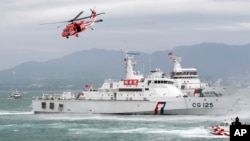A recent attempt by a Chinese man to illegally enter Taiwan after crossing the 180-kilometer-wide Taiwan Strait in a rubber boat is raising concerns on the island about its coastal defense capabilities and overall preparedness amid rising tensions between Beijing and Taipei.
Last Saturday, a 30-year-old Chinese man surnamed Wang was spotted in a dinghy about 100 meters offshore near Taiwan’s northern Linkou District in New Taipei City at about 6:30 in the morning.
After being treated for severe dehydration at a nearby hospital, Wang was detained by local authorities for illegally entering Taiwan. Wang told authorities that he was in debt in China and wanted to start a new life in Taiwan.
Wang is one of 18 Chinese nationals who have tried to illegally enter Taiwan since July of last year. When reached for comment on the cases, Taiwan’s Coast Guard Administration declined to share how many of them were able to reach Taiwan’s shores, like Wang.
In June, a former Chinese naval captain was able to reach the Tamsui ferry pier in Northern Taiwan on a speedboat, shocking many because of how far he was able to get before being detected. At the time, a Chinese man surnamed Ruan said he was fleeing to Taiwan seeking freedom after being threatened by Chinese police for sharing articles critical of the Chinese government.
On Wednesday, however, a court in Taipei sentenced Ruan to eight months in prison for illegally entering Taiwan. He confessed to the crime but claimed his deep knowledge of the Chinese military could help Taiwan cope with threats posed by Beijing.
Some experts say the two Chinese men’s attempts to illegally enter Taiwan expose loopholes in Taiwan’s coastal defense capabilities.
“Even though Taiwan’s defense ministry has highlighted the strategic importance of defending coastal areas in northern Taiwan, Taiwan’s coast guard, which is in charge of coastal defense, has not prioritized setting up advanced surveillance technologies, such as infrared thermal cameras, in these areas, which lead to their failure of detecting the two Chinese men before they reach Taiwanese shores,” said Chieh Chung, a military researcher at the National Policy Foundation in Taiwan.
Some lawmakers from Taiwan’s main opposition party Kuomintang, who favor friendly relations with China, say the two incidents show the Taiwanese government has failed to provide the coast guard with adequate funding and the right equipment to monitor attempted illegal entry.
In response to opposition lawmakers’ criticism of underfunding the coast guard, Taiwan’s Premier Cho Jung-tai vowed to accelerate the review of the recent incidents and determine whether the coast guard needs more advanced technologies or personnel to support their work.
Apart from accelerating the installation of advanced surveillance technologies along coastal areas in northern Taiwan, Chieh said Taiwan’s coast guard should consider strengthening coastal patrols by purchasing commercial drones and increasing coordination with Taiwanese fishermen.
“Taiwan’s coast guard can use commercial drones to help conduct patrols along coastal areas during the day and Taiwanese fishermen could immediately inform the coast guard if they spot any unusual vessels in waters near Taiwanese shores,” he told VOA in a phone interview.
Growing gray zone challenges
Intrusions into Taiwanese waters by Chinese coast guard vessels also are posing a problem for Taiwan’s Coast Guard Administration and raising questions about preparedness. This is particularly true in waters off Taiwan’s outlying Kinmen and Matsu islands, which are just a few kilometers from China’s coast.
Late last week, Taiwan said four Chinese coast guard vessels entered restricted waters near Kinmen, prompting Taipei to deploy four coast guard vessels to drive away the Chinese vessels. The incident was the 39th incursion carried out by Chinese coast guard vessels this year, officials said.
While Beijing describes the incursions, which include boarding Taiwanese vessels, as being part of “law enforcement patrols,” analysts in Taiwan say they challenge Taipei’s territorial claims around its outlying islands and are unilaterally seeking to change the status quo in the Taiwan Strait.
Chieh said since the Taiwanese government has focused on enhancing wartime coordination between the coast guard and the navy over the last few years, it has overlooked the need to strengthen the Taiwanese coast guard’s maritime law enforcement capabilities and upgrade its vessels and training.
“Some of the coast guard vessels that Taiwan purchased in previous years are not suitable to engage in close-range encounters with Chinese coast guard vessels because the structure of those vessels is not solid enough,” he told VOA.
Some analysts suggest Taiwan should carry out a series of reforms to rapidly enhance the coast guard’s capabilities.
“The Taiwanese government should enhance the coast guard’s budget, increase their manpower, and strengthen their law enforcement capabilities by arranging exchanges with other countries’ coast guard,” Su Tzu-yun, a military expert at the Taipei-based Institute for National Defense and Security Research, told VOA by phone.
Military analysts say China likely will maintain high-level pressure on Taiwan through repeated coast guard incursions in the coming months, and Taipei should ensure its coast guard has enough support to cope with the wide range of challenges that Beijing poses.
“Instead of letting the coast guard oversee both Taiwan’s maritime defense and coastal defense, the Taiwanese government should consider assigning some of the responsibilities to the army or the navy,” Lin Ying-yu, a military expert at Tamkang University in Taiwan, told VOA by phone.









